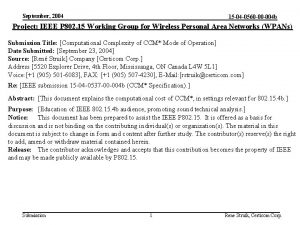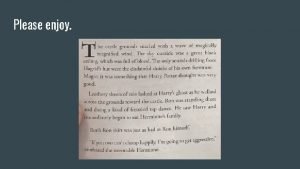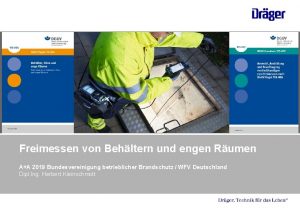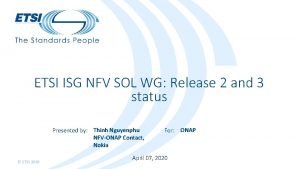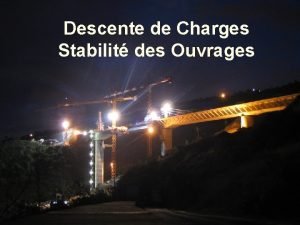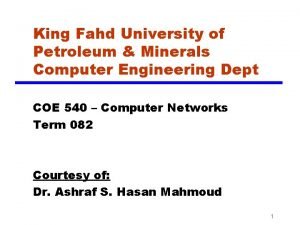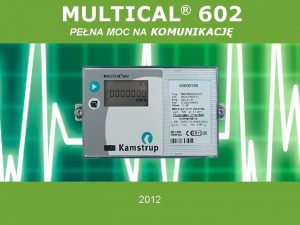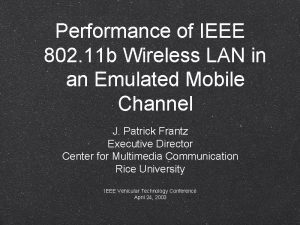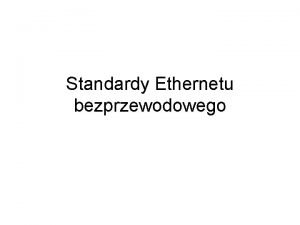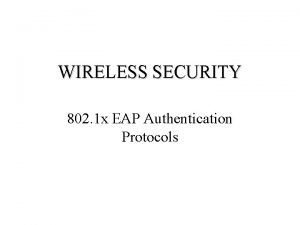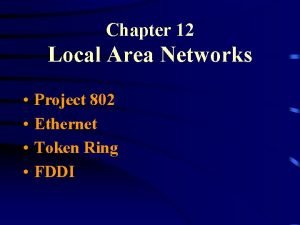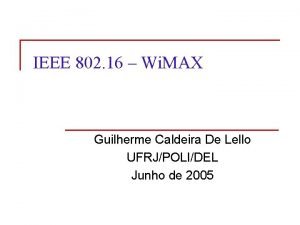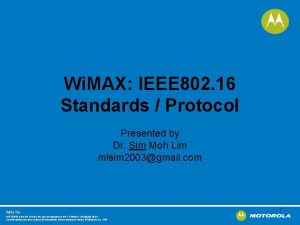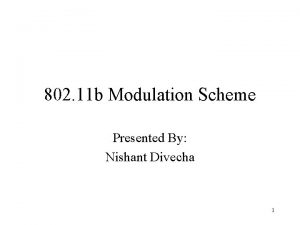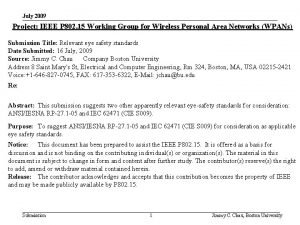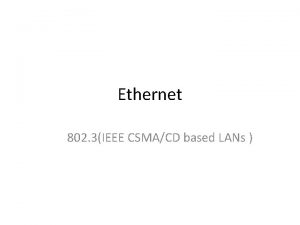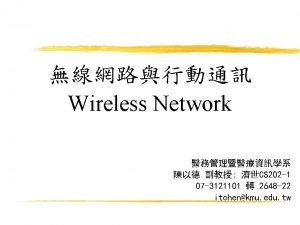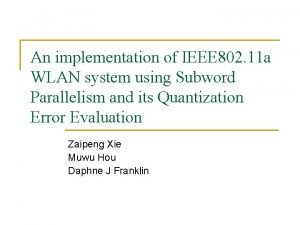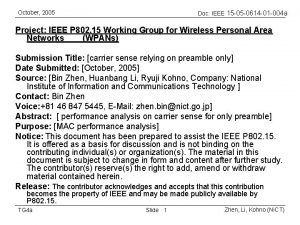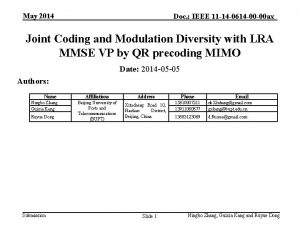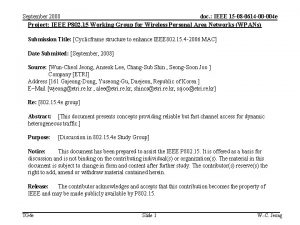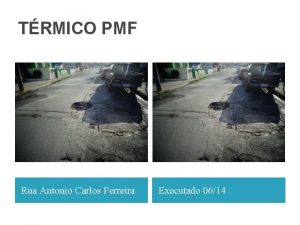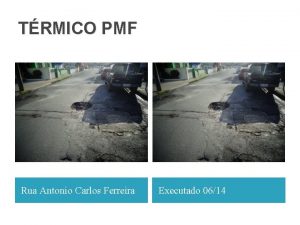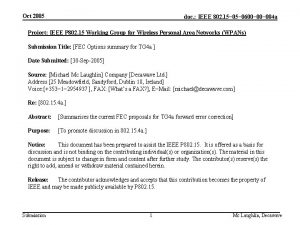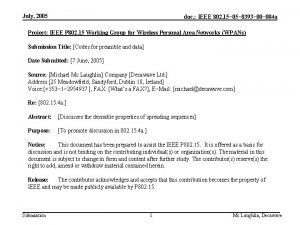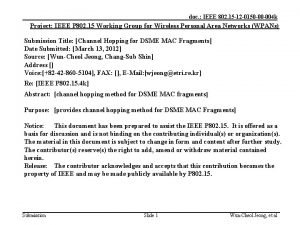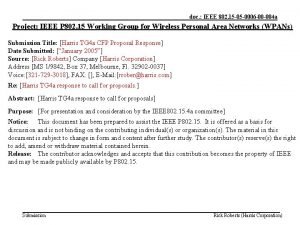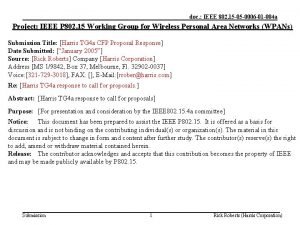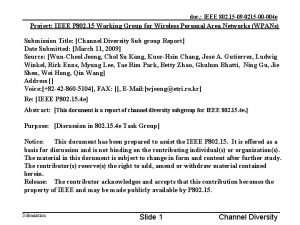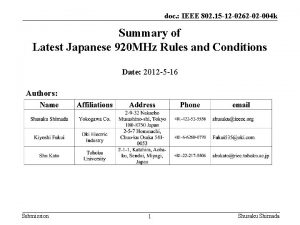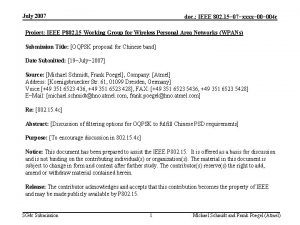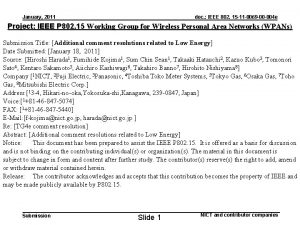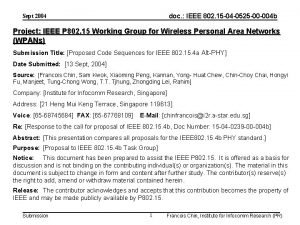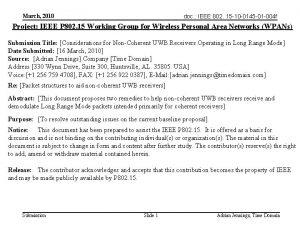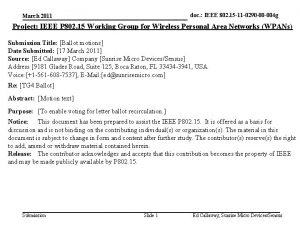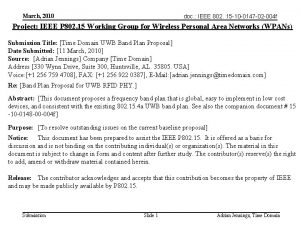doc IEEE 802 15 12 0614 00 004




































- Slides: 36

doc. : IEEE 802. 15 -12 -0614 -00 -004 m November 2012 Project: IEEE P 802. 15 Working Group for Wireless Personal Area Networks (WPANs) Submission Title: Incentive Auction, NPRM FCC 12 -118 Date Submitted: November 11, 2012 Source: Sangsung Choi (ETRI) and Soo-Young Chang (SYCA) Voice: +1 530 574 2741, E-maill: sychang@ecs. csus. edu Re: [802. 15 TG 4 m] Abstract: Recently FCC published an NPRM to have incentive auction. This document summarized the proposed rules in NPRM FCC 12 -118 which may affect Tg 4 m activities. Purpose: To provide information on the FCC rules and activities to the 802. 15 TG 4 m group Notice: This document has been prepared to assist the IEEE P 802. 15. It is offered as a basis for discussion and is not binding on the contributing individual(s) or organization(s). The material in this document is subject to change in form and content after further study. The contributor(s) reserve(s) the right to add, amend or withdraw material contained herein. Release: The contributor acknowledges and accepts that this contribution becomes the property of IEEE and may be made publicly available by P 802. 15. 11/12/2012 Submission Slide 1 1 Sangsung Choi (ETRI)

doc. : IEEE 802. 15 -12 -0614 -00 -004 m November 2012 Incentive Auction NPRM FCC 12 -118 Sangsung Choi and Soo-Young Chang Nov. 2012 11/12/2012 Submission Slide 2 2 Sangsung Choi (ETRI)

doc. : IEEE 802. 15 -12 -0614 -00 -004 m November 2012 TWO AREAS FOR COMMENTS SOUGHT • Two specific issues raised in 2010 wireless microphones further notice, 25 FCC rcd 643 (2010) (1) for a limited expansion of license eligibility that would permit some wireless microphone and other low power auxiliary station users, • which currently operate in the TV broadcast spectrum on an unlicensed basis, • to operate on a licensed basis under the Part 74 rules applicable to low power auxiliary stations (LPAS) (2) what steps to promote more efficient use of this spectrum by wireless microphones • Considerations to be taken into to seek comments in these two areas – recent industry developments, including advances in wireless microphone technologies, – related Commission proceedings that affect use of wireless microphones, including • the TV White Spaces proceeding and • the Incentive Auctions proceeding proposing auction of spectrum currently allocated to television broadcasting * DA 12 -1570, Released: October 5, 2012 11/12/2012 Submission Slide 3 3 Sangsung Choi (ETRI)

doc. : IEEE 802. 15 -12 -0614 -00 -004 m November 2012 2010 WIRELESS MICROPHONES FURTHER NOTICE, 25 FCC Rcd 643 (2010) • Comments sought – comment on the use of wireless microphones and other low power auxiliary stations on an unlicensed basis in the current TV bands (Channels 2 -51, excluding Channel 37). – comment on whether it should revise the Part 74 low power auxiliary station (LPAS) rules to provide for a limited expansion of the categories of entities that would be eligible for licensed use of wireless microphones and other related LPAS. – comment on possible long-term reform, based in part on technological innovations * DA 12 -1570, Released: October 5, 2012 11/12/2012 Submission Slide 4 4 Sangsung Choi (ETRI)

doc. : IEEE 802. 15 -12 -0614 -00 -004 m November 2012 TV WHITE SPACES SECOND MO&O ADOPTED IN SEPTEMBER 2010 • To make unused spectrum in the TV bands available for use by unlicensed TV band devices - “white space devices” • Three types of operations of both licensed and unlicensed wireless microphones addressed with respect to unlicensed white space devices. – White space devices were excluded from two of the unused channels in the UHF TV band near Channel 37 if these channels were available they could be used for wireless microphones. – LPAS licensees could register their wireless microphones (and related low power auxiliary station operations) in the TV bands databases they may be protected from interference from unlicensed white space devices on available channels at specified times. – Certain unlicensed microphone users (e. g. , those operating at major events where wireless microphone operations cannot be accommodated on channels not available for white space devices) were permitted, subject to its approval, to register their wireless microphone operations in the TV bands databases. * DA 12 -1570, Released: October 5, 2012 11/12/2012 Submission Slide 5 5 Sangsung Choi (ETRI)

doc. : IEEE 802. 15 -12 -0614 -00 -004 m November 2012 INCENTIVE AUCTIONS NPRM ADOPTED ON SEPTEMBER 28, 2012 • In the Incentive Auctions NPRM adopted on September 28, 2012, the Commission proposed to repack television stations. – This auction may reduce the spectrum available in the TV bands for secondary use by licensed and unlicensed wireless microphones as well as for unlicensed white space devices. * DA 12 -1570, Released: October 5, 2012 11/12/2012 Submission Slide 6 6 Sangsung Choi (ETRI)

doc. : IEEE 802. 15 -12 -0614 -00 -004 m November 2012 NOTICE OF PROPOSED RULEMAKING, FCC 12118 • Key dates: – Adopted: September 28, 2012, Released: October 2, 2012 – Comment Date: December 21, 2012 – Reply Comment Date: February 19, 2013 • • In the Matter of Expanding the Economic and Innovation Opportunities of Spectrum Through Incentive Auctions, Docket No. 12 -268 2010 National Broadband Plan – introduced the idea of incentive auctions as a tool to help meet the Nation’s spectrum needs. – to ensure that every American has “access to broadband capability. ” – Congress passed the Spectrum Act in early 2012, authorized the Commission to conduct incentive auctions. • Incentive auctions – a voluntary, market-based means of repurposing spectrum by encouraging licensees to voluntarily relinquish spectrum usage rights in exchange for a share of the proceeds from an auction of new licenses to use the repurposed spectrum. * FCC 12 -118, Notice of Proposed Rulemaking, Sep. 28, 2012 11/12/2012 Submission Slide 7 7 Sangsung Choi (ETRI)

doc. : IEEE 802. 15 -12 -0614 -00 -004 m November 2012 INCENTIVE AUCTION OF BROADCAST TELEVISION SPECTRUM • Three pieces of the incentive auction of broadcast television spectrum 1. Reverse auction • broadcast television licensees submit bids to voluntarily relinquish spectrum usage rights in exchange for payments 2. Reorganization or repacking of the broadcast television bands • in order to free up a portion of the ultra high frequency (UHF) band for other uses 3. Forward auction • To grant initial licenses for flexible use of the newly available spectrum. • Each of the three pieces – presents distinct policy, auction design, implementation and other issues, and the statute in a number of cases imposes specific requirements for each piece. – At the same time, all three pieces are interdependent. * FCC 12 -118, Notice of Proposed Rulemaking, Sep. 28, 2012 11/12/2012 Submission Slide 8 8 Sangsung Choi (ETRI)

doc. : IEEE 802. 15 -12 -0614 -00 -004 m November 2012 REVERSE AUCTION OF BROADCAST TELEVISION SPECTRUM • The issues presented by the reverse auction – bid collection, – determination of which bids are accepted, – determination of payment amounts to winners. • Spectrum Act (Title VI of the Middle Class Tax Relief and Job Creation Act of 2012) – limits eligibility to participate in the reverse auction to commercial and noncommercial full power and Class A broadcast television licensees. * FCC 12 -118, Notice of Proposed Rulemaking, Sep. 28, 2012 11/12/2012 Submission Slide 9 9 Sangsung Choi (ETRI)

doc. : IEEE 802. 15 -12 -0614 -00 -004 m November 2012 REPACKING OF BROADCAST TELEVISION SPECTRUM (1) • To make “all reasonable efforts” to preserve the “coverage area and population served” of television stations – whether “coverage area” can be interpreted to mean a full power television station’s “service area”? * FCC 12 -118, Notice of Proposed Rulemaking, Sep. 28, 2012 11/12/2012 Submission Slide 10 10 Sangsung Choi (ETRI)

doc. : IEEE 802. 15 -12 -0614 -00 -004 m November 2012 REPACKING OF BROADCAST TELEVISION SPECTRUM (2) • One proposed band plan for reclaimed broadcast television spectrum using 5 megahertz blocks – The uplink band would begin at channel 51 (698 MHz) and expand downward toward channel 37 based on the amount of reclaimed spectrum. – The downlink band would begin at channel 36 (608 MHz) and likewise expand downward. – Establishing 6 megahertz guard bands between mobile broadband use and broadcast use, consistent with the Spectrum Act, and propose to make this spectrum available for unlicensed use. * FCC 12 -118, Notice of Proposed Rulemaking, Sep. 28, 2012 11/12/2012 Submission Slide 11 11 Sangsung Choi (ETRI)

doc. : IEEE 802. 15 -12 -0614 -00 -004 m November 2012 REPACKING OF BROADCAST TELEVISION SPECTRUM (3) • Comment sought on – a number of alternative band plan approaches. – whether or not to relocate the Radio Astronomy Service and wireless medical telemetry systems now operating on channel 37, – whether and how to address the post-auction availability of UHF band spectrum for fixed broadcast auxiliary stations, low power auxiliary stations, and unlicensed wireless microphones. • In the white space and unlicensed operations section, – Measures, taken together, would make a substantial amount of spectrum available for unlicensed uses, including a significant portion that would be available on a uniform nationwide basis for the first time. – Television white spaces will continue to be available for unlicensed use in the repacked television band. – It is proposed to make the following bands available for unlicensed use - available for white space devices : • the guard band spectrum in the proposed 600 MHz band plan, • channel 37, and • two channels currently designated for wireless microphone use. * FCC 12 -118, Notice of Proposed Rulemaking, Sep. 28, 2012 11/12/2012 Submission Slide 12 12 Sangsung Choi (ETRI)

doc. : IEEE 802. 15 -12 -0614 -00 -004 m November 2012 CURRENT BROADCAST TELEVISION BANDS (1) The broadcast television bands occupy 294 megahertz of spectrum in five frequency bands – 54 -72 MHz (low VHF channels 2 -4), 76 -88 MHz (low VHF channels 5 -6), 174 -216 MHz (high VHF channels 7 -13), 470 -608 MHz (UHF channels 14 -36) and 614 -698 MHz (UHF channels 38 -51). – The 470 -512 MHz band segment (UHF channels 14 -20) is allocated for fixed and land mobile services on a co-primary basis with broadcasting. • Broadcast Television – Broadcast television stations operate on six-megahertz channels designated 2 to 51. • Broadcast Auxiliary Service – Under Subpart G of Part 74, certain broadcast auxiliary operations (“BAS”) also are permitted on television channels 14 -69 on a secondary basis. – Only licensees of a full power broadcast television station, a Class A station, a television broadcast network entity, or a low power television station may hold fixed BAS licenses on channels 14 -51. – Specifically, section 74. 602(h) permits television studio transmitter links (STLs), television relay stations, and television translator relay stations to operate fixed point-to-point service on UHF channels 14 -69 on a secondary basis. * FCC 12 -118, Notice of Proposed Rulemaking, Sep. 28, 2012 11/12/2012 Submission Slide 13 13 Sangsung Choi (ETRI)

doc. : IEEE 802. 15 -12 -0614 -00 -004 m November 2012 CURRENT BROADCAST TELEVISION BANDS (2) • Low Power Auxiliary Stations / Wireless Microphones. – Under Subpart H of Part 74, the Commission permits specified licensed entities to operate wireless microphones and other low power auxiliary transmitters (Low Power Auxiliary Stations, or “LPAS”) on vacant channels in the broadcast television bands on a secondary, non-interference basis. – In addition, the Commission currently permits certain unlicensed operations of wireless microphones (and related devices) in the broadcast television bands pursuant to a limited waiver under the Commission’s Part 15 rules. – In the television white spaces proceeding, the Commission excluded television white space devices from two of the unused channels in the UHF band near channel 37 so that if these channels became available, they could be used for wireless microphones. • Channel 37 – Channel 37 (608 -614 MHz) is not allocated for broadcast television but rather is used for receive-only radio astronomy observations (RAS) and for wireless medical telemetry service (WMTS), on a non-interfering basis to radio astronomy, under Part 95 of our rules. * FCC 12 -118, Notice of Proposed Rulemaking, Sep. 28, 2012 11/12/2012 Submission Slide 14 14 Sangsung Choi (ETRI)

doc. : IEEE 802. 15 -12 -0614 -00 -004 m November 2012 CURRENT BROADCAST TELEVISION BANDS (3) • White Space and Unlicensed Devices. – The Commission’s Part 15 rules provide for the operation of low power radio transmitters on an unlicensed basis in the broadcast television bands, as well as in other spectrum bands. – In 2008 and 2010, the Commission authorized the operation in the broadcast television bands of “white space” devices in areas where specific channels are not used by television or other protected services. White space devices employ novel cognitive radio techniques to identify television channels that are not being used by licensed services at or near a device’s location. • Guard Band Availability for Unlicensed Use – It is proposed to make the guard band spectrum available for unlicensed white space device use on a non-interference basis. * FCC 12 -118, Notice of Proposed Rulemaking, Sep. 28, 2012 11/12/2012 Submission Slide 15 15 Sangsung Choi (ETRI)

doc. : IEEE 802. 15 -12 -0614 -00 -004 m November 2012 TECHNICAL ASPECTS OF THE REPACKING PROCESS • Some limitations on freeing up spectrum (OET Bulletin 69) – The FCC must “make all reasonable efforts to preserve, as of the date of the enactment of this Act, the coverage area and population served of each broadcast television licensee, as determined using the methodology described in OET Bulletin 69. * FCC 12 -118, Notice of Proposed Rulemaking, Sep. 28, 2012 11/12/2012 Submission Slide 16 16 Sangsung Choi (ETRI)

doc. : IEEE 802. 15 -12 -0614 -00 -004 m November 2012 FORWARD AUCTION—RECONFIGURING THE UHF BAND • Allocations – It is considered whether to relocate existing radio astronomy and wireless medical telemetry systems on channel 37 (608 -614 MHz) to new spectrum. – To adopt a band plan that will provide for flexible use of these bands for new wireless broadband services while continuing to support existing uses. * FCC 12 -118, Notice of Proposed Rulemaking, Sep. 28, 2012 11/12/2012 Submission Slide 17 17 Sangsung Choi (ETRI)

doc. : IEEE 802. 15 -12 -0614 -00 -004 m November 2012 FORWARD AUCTION—RECONFIGURING THE UHF BAND (1) • • What is 600 MHz Band Plan – A band plan created from relinquished broadcast spectrum usage rights Overview of the Band Plan – A band plan that balances flexibility with certainty, accommodating varying amounts of available wireless spectrum in different geographic areas rather than requiring that a uniform set of television channels be cleared nationwide. – A structure to keep the downlink spectrum band consistent nationwide while allowing variations in the amount of uplink spectrum available in any geographic area. • by keeping the downlink spectrum consistent nationwide, we can help ensure that wireless providers will be able to offer mobile devices that can operate across the country, which should minimize device cost and interoperability concerns, and allow for greater economies of scale. – Designating specific uplink and downlink blocks, pairing them where possible, to support expansion of cutting-edge wireless broadband technologies. * FCC 12 -118, Notice of Proposed Rulemaking, Sep. 28, 2012 11/12/2012 Submission Slide 18 18 Sangsung Choi (ETRI)

doc. : IEEE 802. 15 -12 -0614 -00 -004 m November 2012 FORWARD AUCTION—RECONFIGURING THE UHF BAND (2) • Goals of 600 MHz Band Plan – five key policy goals: utility, certainty, interchangeability, quantity, and interoperability – using 5 megahertz “building blocks” – pairing these blocks wherever possible. – technical solutions proposed to ensure that the spectrum blocks are as free from interference as possible. – It was considered whether using technical solutions such as guard bands can make the spectrum blocks more closely interchangeable. – maximizing the amount of spectrum we can repurpose for both licensed and unlicensed wireless broadband services from the voluntarily relinquished broadcast television spectrum usage rights. * FCC 12 -118, Notice of Proposed Rulemaking, Sep. 28, 2012 11/12/2012 Submission Slide 19 19 Sangsung Choi (ETRI)

doc. : IEEE 802. 15 -12 -0614 -00 -004 m November 2012 FORWARD AUCTION—RECONFIGURING THE UHF BAND (3) • Goals of 600 MHz Band Plan (continued) – To allow for wide band radio operations using common radio components and improvements to reduce interoperability concerns as technology evolves over time – To accommodate variations in the amount of uplink spectrum: vary the total amount of spectrum available by area – To increase the quantity of wireless spectrum for unlicensed use by allowing for unlicensed use in the proposed guard bands and in any excess spectrum that is too small to license on a 5 megahertz block basis, supplementing current unlicensed use in existing white spaces. * FCC 12 -118, Notice of Proposed Rulemaking, Sep. 28, 2012 11/12/2012 Submission Slide 20 20 Sangsung Choi (ETRI)

doc. : IEEE 802. 15 -12 -0614 -00 -004 m November 2012 600 MHz BAND PLAN (1) • 600 MHz Spectrum Band – The establishment of a 600 MHz band plan approach using 5 megahertz blocks – the uplink band begins at channel 51 (698 MHz), and, depending on the amount of spectrum available from the spectrum usage rights that broadcasters voluntarily relinquish in the reverse auction, will expand downward toward channel 37. – The downlink band would begin at channel 36 (608 MHz) and expand downward based on the amount of reclaimed spectrum. * FCC 12 -118, Notice of Proposed Rulemaking, Sep. 28, 2012 11/12/2012 Submission Slide 21 Figure 4. 600 MHz Band Plan 21 Sangsung Choi (ETRI)

doc. : IEEE 802. 15 -12 -0614 -00 -004 m November 2012 600 MHz BAND PLAN (2) • Block size of 600 MHz Spectrum Band – It is proposed to license the 600 MHz spectrum in 5 megahertz “building blocks. ” – comment sought on licensing the 600 MHz spectrum in 6 megahertz blocks. – Larger blocks to be facilitated by the aggregation of larger contiguous blocks composed of multiple 5 megahertz building blocks. • Block Configuration – to offer a uniform amount of downlink spectrum. – to offer varying amounts of uplink spectrum in each service area, depending on the amount of spectrum available. – to pair spectrum for FDD operations when possible, but may yield varying amounts of unpaired downlink spectrum blocks in different areas. • Paired Blocks: Existing transmission procedures for mobile broadband FDD operations generally operated on paired spectrum bands. • Unpaired spectrum: to propose to offer unpaired downlink spectrum that can serve as supplemental downlink expansion for FDD operations where we have excess wireless spectrum that cannot be paired. Licensing the unpaired downlink spectrum in 5 megahertz increments is considered too. * FCC 12 -118, Notice of Proposed Rulemaking, Sep. 28, 2012 11/12/2012 Submission Slide 22 22 Sangsung Choi (ETRI)

doc. : IEEE 802. 15 -12 -0614 -00 -004 m November 2012 600 MHz BAND PLAN (3) • Offering Different Amounts of Spectrum in Different Markets – The alternative – requiring the same amount of broadcast spectrum to be cleared in all markets – would limit the total amount of spectrum usage rights that broadcasters can choose to relinquish and that wireless providers can use for wireless broadband services. Figure 5. Fixed downlink with uplink varying by market * FCC 12 -118, Notice of Proposed Rulemaking, Sep. 28, 2012 11/12/2012 Submission Slide 23 23 Sangsung Choi (ETRI)

doc. : IEEE 802. 15 -12 -0614 -00 -004 m November 2012 600 MHz BAND PLAN (4) • Band Plan “Families” with Consistent Nationwide Downlink Bandwidth – A band plan “family” is a group of possible band plans with a consistent amount of nationwide downlink spectrum to allow for market-by-market differences in the quantity of uplink spectrum. * FCC 12 -118, Notice of Proposed Rulemaking, Sep. 28, 2012 11/12/2012 Submission Slide 24 Figure 6. Example family for minimum clearing of 7 channels 24 Sangsung Choi (ETRI)

doc. : IEEE 802. 15 -12 -0614 -00 -004 m November 2012 600 MHz BAND PLAN (5) • “Extended Families” Using Multiple Downlink Band Plans – If broadcasters voluntarily relinquish spectrum usage rights in more spectrum than can be supported in one pass band due to current technical limitations, we may need to support two downlink band plans from the outset. Figure 7. Example of family requiring two filters * FCC 12 -118, Notice of Proposed Rulemaking, Sep. 28, 2012 11/12/2012 Submission Slide 25 25 Sangsung Choi (ETRI)

doc. : IEEE 802. 15 -12 -0614 -00 -004 m November 2012 600 MHz BAND PLAN (6) • “Extended Families” Using Multiple Downlink Band Plans – Mobile devices would need two filters rather than one filter to support service in the entire band Figure 8. Two related plans based on aligning filters, an “extended family” * FCC 12 -118, Notice of Proposed Rulemaking, Sep. 28, 2012 11/12/2012 Submission Slide 26 26 Sangsung Choi (ETRI)

doc. : IEEE 802. 15 -12 -0614 -00 -004 m November 2012 600 MHz BAND PLAN (7) • “Extended Families” Using Multiple Downlink Band Plans * FCC 12 -118, Notice of Proposed Rulemaking, Sep. 28, 2012 11/12/2012 Submission Slide 27 Figure 9. Example of an extended family combining two families 27 Sangsung Choi (ETRI)

doc. : IEEE 802. 15 -12 -0614 -00 -004 m November 2012 GEOGRAPHIC AREA LICENSING • It is proposed to license the 600 MHz band using a geographic area licensing approach. * FCC 12 -118, Notice of Proposed Rulemaking, Sep. 28, 2012 11/12/2012 Submission Slide 28 28 Sangsung Choi (ETRI)

doc. : IEEE 802. 15 -12 -0614 -00 -004 m November 2012 TECHNICAL CONSIDERATIONS, GUARD BANDS • • • In order to minimize interference between dissimilar adjacent operations, it is proposed to create guard bands in which there are no high powered operations. These guard bands may be used for low-powered unlicensed operations that are secondary and cannot cause interference. A six megahertz guard band is proposed to protect television operations and 600 MHz uplink and downlink operations. Additionally, it is proposed to add “remainder” spectrum to the guard bands to further mitigate any potential interference concerns. Figure 10. Guard band locations in the proposed band plan * FCC 12 -118, Notice of Proposed Rulemaking, Sep. 28, 2012 11/12/2012 Submission Slide 29 29 Sangsung Choi (ETRI)

doc. : IEEE 802. 15 -12 -0614 -00 -004 m November 2012 TECHNICAL CONSIDERATIONS, REMAINDER SPECTRUM FOR UNLICENSED USE • There could be between 6 and 10 megahertz of spectrum for a guard band, which means between 0 and 4 megahertz of spectrum for remainder spectrum. * FCC 12 -118, Notice of Proposed Rulemaking, Sep. 28, 2012 11/12/2012 Submission Slide 30 30 Sangsung Choi (ETRI)

doc. : IEEE 802. 15 -12 -0614 -00 -004 m November 2012 TECHNICAL CONSIDERATIONS, DUPLEX GAP • Required separation between the uplink and downlink bands – The duplex spacing is 90 megahertz, but a specific size for the duplex gap is not proposed. Figure 11. Illustration of duplexing terminology * FCC 12 -118, Notice of Proposed Rulemaking, Sep. 28, 2012 11/12/2012 Submission Slide 31 31 Sangsung Choi (ETRI)

doc. : IEEE 802. 15 -12 -0614 -00 -004 m November 2012 ALTERNATIVE BAND PLAN APPROACHES (1) Figure 12. Alternative Approach, Down from 51 Figure 13. Impact of Fixed 37 on Down from 51 Alternative Approach * FCC 12 -118, Notice of Proposed Rulemaking, Sep. 28, 2012 11/12/2012 Submission Slide 32 32 Sangsung Choi (ETRI)

doc. : IEEE 802. 15 -12 -0614 -00 -004 m November 2012 ALTERNATIVE BAND PLAN APPROACHES (2) Figure 14. Alternatives, Relocation of Channel 37 Figure 15. Alternatives, In from Channels 51 and 21 * FCC 12 -118, Notice of Proposed Rulemaking, Sep. 28, 2012 11/12/2012 Submission Slide 33 33 Sangsung Choi (ETRI)

doc. : IEEE 802. 15 -12 -0614 -00 -004 m November 2012 TECHNICAL RULES (1) • To establish technical rules that maximize flexible use of the spectrum while appropriately protecting incumbent operations in neighboring bands. • OOBE Limits – OOBE (Out-Of-Band Emission) attenuation of 43+10*log 10(P) d. B for 600 MHz band where P is the transmit power in watts and the measurement bandwidth is 100 k. Hz. • Power Limits – 600 MHz Downlink Operations: • to limit fixed and base station power for downlink operations in non-rural areas to 1000 watts per MHz ERP for emission bandwidths less than 1 MHz and to 1000 watts per MHz ERP for emission bandwidths greater than 1 MHz, and to double these limits (2000 watts ERP) in rural areas. – 600 MHz Uplink Operations: • power limit of 3 watts ERP for both portables and mobiles and prohibit fixed and base station operations * FCC 12 -118, Notice of Proposed Rulemaking, Sep. 28, 2012 11/12/2012 Submission Slide 34 34 Sangsung Choi (ETRI)

doc. : IEEE 802. 15 -12 -0614 -00 -004 m November 2012 TECHNICAL RULES (2) • Antenna Height Restrictions – to apply the 700 MHz flexible antenna height rules, as set forth in 27. 50(c) • Co-Channel Interference Among 600 MHz Systems – setting a field strength limit of 40 d. BμV/m at the edge of the license area. • Canadian and Mexican Coordination – Section 27. 57(b) of our rules indicates that 700 MHz operations are subject to international agreements with Mexico and Canada. – Modification of the 700 MHz band arrangements or the creation of new separate arrangements pertaining to the 600 MHz spectrum will be necessary to implement 600 MHz operations in areas along the common border and to protect these 600 MHz operations from cross-border interference. * FCC 12 -118, Notice of Proposed Rulemaking, Sep. 28, 2012 11/12/2012 Submission Slide 35 35 Sangsung Choi (ETRI)

doc. : IEEE 802. 15 -12 -0614 -00 -004 m November 2012 POSSIBLE IMPACTS FROM THIS AUCTION • Spectrum to be available to TVBD devices can be reduced due to shrinking the TV broadcast bands. – Rural areas will experience more serious reduction. – Unlicensed usage also can be reduced with the same reason. • Unlicensed usage in channel 37 and guard bands may allow more spectrum to the unlicensed low power radio users, – but with restrictions for TVBD devices to protect licensed users in these bands because licensed usage in channel 37 and guard bands will be protected using geo-location database approach. 11/12/2012 Submission Slide 36 36 Sangsung Choi (ETRI)
 Bridges from 802.x to 802.y
Bridges from 802.x to 802.y Bridges from 802.x to 802.y
Bridges from 802.x to 802.y Rtog 0933
Rtog 0933 Ieee802.22
Ieee802.22 Arquitetura ieee 802
Arquitetura ieee 802 Norma ieee 802
Norma ieee 802 Ieee 802 standard
Ieee 802 standard Bluetooth ieee 802
Bluetooth ieee 802 802 ieee
802 ieee Ieee 802
Ieee 802 Ieee 802 family
Ieee 802 family Ieee 802 3 compliance
Ieee 802 3 compliance 0560 004
0560 004 700 004
700 004 Auec2-004
Auec2-004 Wer darf behälter freimessen?
Wer darf behälter freimessen? Sol 005
Sol 005 Croix de saint andré charpente métallique
Croix de saint andré charpente métallique Team-004
Team-004 Pyp 004 kfupm
Pyp 004 kfupm Filler 602
Filler 602 Geo 802
Geo 802 802 11 b
802 11 b Standardy 802
Standardy 802 802 5
802 5 802 eap
802 eap Project 802
Project 802 802 16
802 16 802 protocols
802 protocols 802 16
802 16 802 11
802 11 09 802 0561
09 802 0561 Ethernet 802
Ethernet 802 802 family
802 family Lan 701
Lan 701 Ccna 640-802
Ccna 640-802 Wlan 802
Wlan 802












